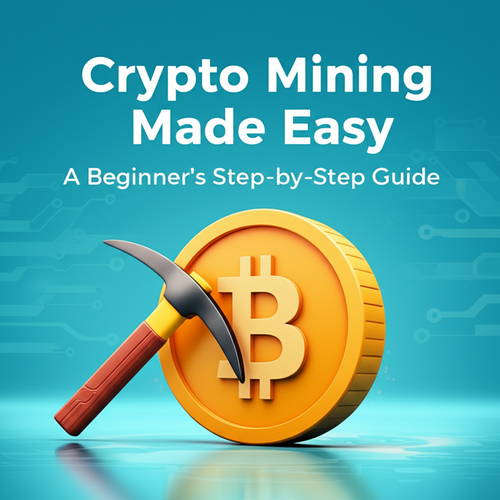Are you curious about the world of cryptocurrency and looking for a way to participate beyond just buying and selling? Crypto mining, the process of verifying transactions and adding them to the blockchain in exchange for rewards, might be your answer. This comprehensive guide will walk complete beginners through the essential steps, from understanding the basics to choosing hardware and software, helping you start your mining journey.
For many, crypto mining represents a unique opportunity to earn passive income while contributing to the security and decentralization of a digital network. While it might sound complex, breaking it down into manageable steps makes it accessible. We’ll cover everything you need to know to get started, from setting up your digital wallet to selecting the right equipment and joining a mining pool.
Understanding the Basics: What is Crypto Mining?
At its core, crypto mining is the process by which new coins are introduced into circulation and new transactions are verified and added to the blockchain ledger. Miners use powerful computers to solve complex computational puzzles. When a miner successfully solves a puzzle, they get to add a new block of verified transactions to the blockchain and are rewarded with newly minted cryptocurrency, plus transaction fees.
This process, often referred to as “Proof-of-Work” (PoW), is crucial for maintaining the security and integrity of decentralized networks like Bitcoin. It prevents fraud and ensures that all participants agree on the state of the ledger. Think of miners as digital accountants, constantly balancing the books and ensuring everything is legitimate.
Why Consider Crypto Mining?
- Potential for Passive Income: Earn cryptocurrency rewards for your computational effort.
- Support Decentralization: Contribute to the security and stability of the network, making it more robust.
- Learn New Skills: Gain hands-on experience with blockchain technology and hardware setup.
- Hedge Against Inflation: For some, holding mined crypto is a way to diversify assets.
Step 1: Choose Your Cryptocurrency Wisely
Before you invest in any hardware, you need to decide which cryptocurrency you want to mine. Different cryptocurrencies use different algorithms and, therefore, require different types of mining hardware.
- Bitcoin (BTC): The original and largest cryptocurrency, Bitcoin uses the SHA-256 algorithm and can only be mined profitably with specialized hardware called ASICs (Application-Specific Integrated Circuits).
- Ethereum (ETH): While Ethereum transitioned to Proof-of-Stake (PoS) in 2022, effectively ending GPU mining on its network, many other popular coins are still mineable with GPUs. This includes coins like Ethereum Classic (ETC), RavenCoin (RVN), and Flux (FLUX).
- Altcoins: There are thousands of other cryptocurrencies (altcoins) that can be mined using GPUs or, in some cases, even CPUs (though CPU mining is rarely profitable for major coins). Researching emerging projects can sometimes reveal opportunities.
Factors to consider when choosing a coin include its profitability (which fluctuates daily), network difficulty, future prospects, and the community supporting it. Use online profitability calculators (e.g., WhatToMine.com) to compare potential earnings for different coins and hardware combinations.
Step 2: Get a Reliable Crypto Wallet
Once you start mining, you’ll need a secure place to store your earned cryptocurrency. A crypto wallet is a digital tool that allows you to manage your public and private keys, enabling you to send and receive digital assets. There are several types of wallets:
- Software Wallets: These are applications you install on your computer (desktop wallets) or smartphone (mobile wallets). Examples include Exodus, Electrum, and Trust Wallet. They offer a good balance of security and convenience.
- Hardware Wallets: These are physical devices that store your private keys offline, providing the highest level of security against online threats. Popular choices include Ledger and Trezor. Highly recommended for storing significant amounts of crypto.
- Web Wallets (Exchange Wallets): These are wallets provided by cryptocurrency exchanges. While convenient for trading, they are generally less secure for long-term storage as you don’t control the private keys (a common adage is “not your keys, not your crypto”).
Always choose a reputable wallet and ensure you understand how to back up your recovery phrase (seed phrase) securely. Never share your private keys or seed phrase with anyone.
Step 3: Select Your Mining Hardware
This is often the most significant investment for new miners. Your choice of hardware depends heavily on the cryptocurrency you want to mine and your budget.
Types of Mining Hardware:
- CPU Mining: Uses your computer’s Central Processing Unit. While technically possible, it’s rarely profitable for major cryptocurrencies due to high electricity costs and low hash rates compared to other methods.
- GPU Mining: Uses Graphics Processing Units (graphics cards) primarily designed for gaming. GPUs are versatile and can mine a wide range of altcoins. Building a “mining rig” involves multiple GPUs connected to a motherboard. This was historically popular for Ethereum.
- ASIC Mining: Application-Specific Integrated Circuits are purpose-built machines designed to mine one specific cryptocurrency (or a group of coins using the same algorithm) with extreme efficiency. ASICs are dominant for Bitcoin mining but are expensive and less versatile.
When choosing hardware, consider not only the upfront cost but also:
- Hash Rate: How many calculations per second the hardware can perform. Higher is better.
- Power Consumption: Mining consumes a lot of electricity. Calculate your expected electricity costs to determine profitability.
- Cooling: Mining hardware generates significant heat. Proper ventilation and cooling are essential to prevent damage and ensure longevity.
- Noise: Mining rigs can be very noisy, especially ASICs.
Reputable ASIC manufacturers include Bitmain (Antminer) and Canaan (AvalonMiner). For GPU mining, NVIDIA (RTX series) and AMD (Radeon series) are popular choices. Remember to factor in the cost of a power supply unit (PSU) capable of handling your entire rig, a motherboard, RAM, and a basic operating system.
Step 4: Join a Mining Pool
Unless you have an enormous amount of mining power (like a large farm), trying to mine solo is akin to winning the lottery – highly unlikely. Mining pools combine the computational power of many individual miners, significantly increasing the chances of solving a block and earning rewards.
When a pool successfully mines a block, the reward is split among all participants according to their contribution (their “hash rate”). This provides a more consistent, albeit smaller, stream of income compared to the rare, large payouts of solo mining.
When selecting a mining pool, look for:
- Reputation and Reliability: Choose well-established pools with a proven track record.
- Pool Size: Larger pools offer more frequent payouts due to higher collective hash rates.
- Fees: Pools charge a percentage fee (typically 1-3%) on your earnings.
- Payout Thresholds: The minimum amount of crypto you need to accumulate before the pool sends it to your wallet.
- Server Locations: Choose a server geographically close to you to minimize latency (ping).
Popular mining pools include F2Pool, AntPool, ViaBTC, and unMineable (for GPU altcoin mining). Visit their websites to learn about their specific setup instructions and supported coins.
Step 5: Install Mining Software
With your hardware set up and your pool chosen, the final step before powering up is installing the right mining software. This software connects your hardware to the mining pool and directs its computational power to solve the puzzles.
- For ASICs: Most ASICs come with pre-installed firmware. You simply need to configure it via a web interface, pointing it to your chosen mining pool and entering your wallet address.
- For GPUs: Common software includes Ethminer (though mostly for legacy Ethereum PoW), lolMiner, T-Rex Miner, and Claymore’s Dual Miner (for specific coins). These often run on Windows or Linux and are configured via batch files or command-line interfaces.
- Operating Systems: While you can mine on Windows, dedicated mining operating systems like HiveOS or RaveOS offer optimized performance, easier remote management, and better stability for large GPU rigs.
Carefully follow the instructions provided by your chosen mining pool and software. You’ll typically need to input your pool’s server address, port number, and your wallet address (or a username provided by the pool) to receive payouts.
Step 6: Power Up and Monitor Your Rig
Once everything is configured, it’s time to power on your mining rig. Monitor its performance closely, especially in the initial hours and days. Key metrics to watch include:
- Hash Rate: Ensure your hardware is performing at its expected rate.
- Temperature: Keep an eye on GPU/ASIC temperatures to prevent overheating.
- Fan Speed: Adjust fan speeds to maintain optimal temperatures.
- Rejected Shares: A high number of rejected shares can indicate unstable overclocks, network issues, or outdated software.
- Power Consumption: Monitor your electricity usage to ensure profitability.
Most mining software and pools offer dashboards where you can track these statistics. Regular maintenance, software updates, and monitoring are crucial for efficient and profitable mining.
The Practical Benefits and Future of Crypto Mining
Beyond the direct financial rewards, engaging in crypto mining offers several practical benefits. It provides a deeper understanding of blockchain technology, cryptography, and network security. For some, it’s a way to actively support a decentralized future, contributing to networks that are resistant to censorship and single points of failure. The process itself can be a fascinating technical hobby, merging hardware configuration with software optimization.
Looking ahead, the landscape of crypto mining is constantly evolving. The shift of Ethereum to Proof-of-Stake highlights a move towards more energy-efficient consensus mechanisms. However, Proof-of-Work still underpins major cryptocurrencies like Bitcoin, which continue to attract significant investment in mining infrastructure. Future predictions suggest increased innovation in ASIC technology, a focus on renewable energy sources for mining operations, and the emergence of new PoW-based altcoins that could offer mining opportunities. Regulatory environments will also play a crucial role in shaping the future of decentralized mining.
Conclusion: Your Mining Journey Starts Here
Starting your crypto mining journey can be an exciting venture into the world of blockchain technology. While it requires an initial investment in hardware and time to learn the ropes, following these steps will equip you with the foundational knowledge needed to begin. Remember to continually research, adapt to market changes, and prioritize the security of your assets.
Ready to take the plunge? Start by researching which cryptocurrency aligns with your goals and budget, then secure a reliable wallet. The world of crypto mining is waiting for you to contribute!
For more detailed information on specific hardware or software, consider checking out forums like r/gpumining on Reddit or the official documentation for Bitcoin at Bitcoin.org.






